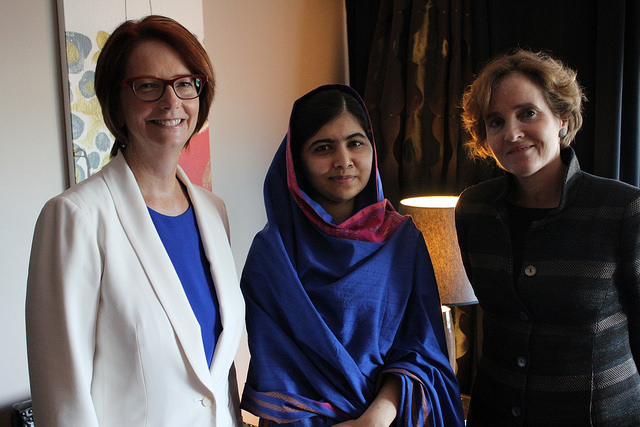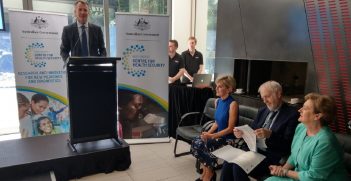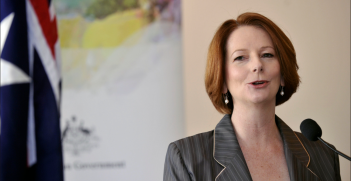The Foundations of Sustainability Lie in Education

Representatives from the Global Partnership for Education, chaired by former prime minister Julia Gillard, will be in Canberra over the coming week to push for further funding to address worldwide inequalities in education. Australia has an important role to play, particularly when it comes to the fragile countries of the Asia-Pacific region.
Every day I count myself lucky that I received a top-quality education and remind myself that in low-income countries, only around half of all girls and boys complete primary school. I also think about the 130 million girls and boys who receive an education of such poor quality that they are unable to recognise numbers or a simple sentence.
If such inequality in education persists, there is no hope of laying the foundations of a fairer, more prosperous future. Investment in education is essential to achieving any one of the 17 globally agreed Sustainable Development Goals (SDG). Improving access to and quality of learning is fundamental to eradicating extreme poverty and preventing the spread of deadly diseases.
It is key to reducing early marriage and enabling girls to gain the same powers and rights as their brothers. If we do not find ways to educate rising numbers of refugees and displaced people, we are creating a generation of unskilled and vulnerable young people who have lost their chance at learning and earning a decent living.
In a few days, I will be in Australia to discuss the government’s commitment to continuing our work together. Australia is a long-standing donor to the Global Partnership for Education (GPE) and has demonstrated consistent political commitment to investing in education in the world’s poorest countries. This is both the right thing to do and the smart thing to do. While Australia is a peaceful and prosperous country, we know that global challenges affect us all.
Around half of Australia’s development aid is directed to countries in the Asia-Pacific region that are considered fragile. Tackling challenges in these countries requires governments to address structural inequality, especially between urban and rural populations, majority and minority populations and girls and boys. As access to quality education is essential to reduce inequality and establish the foundations of fairness in any society, I hope that Australia and other donors will step up commitments to education via GPE in the coming years.
Operating in more than 65 countries, GPE is both a partnership and global fund, employing a unique operating model that puts developing country partners in the driver’s seat. The developing country partners lead the planning and implementation of education reform because they have to be responsible and accountable for delivering education to their citizens.
It also means that developing countries themselves provide the majority of the funding: in order to receive GPE support, countries are expected to gradually increase domestic spending on education to around 20 per cent of their national budgets.
What GPE brings is financial and technical assistance to improve education sector planning and long-term strengthening of the education system. The partnership ensures that countries address barriers to education including gender, disability, rural versus urban needs and social barriers such as caste and ethnicity.
Change in education takes time, but we can see the results clearly in improved gender parity and learning outcomes. For example, GPE support in partner countries has seen 8.7 million more girls attending school between 2002 and 2015. And many more girls complete primary school: an increase from 57 per cent in 2002 to 75 per cent in 2015.
In the Asia-Pacific region, GPE funding helps young children from disadvantaged backgrounds in Cambodia to receive an early childhood education, a critical intervention to improve learning outcomes throughout a child’s school life. This includes construction of pre-schools, community-based pre-school programs and teacher training. GPE funding is helping to develop national maths and reading assessments and supports in-school vision screening.
In Papua New Guinea, which joined GPE in 2010, GPE supports READ PNG, a reading-skills program that funds classroom libraries, teacher training and the introduction of reading assessment tools to better monitor students’ progress. Under our new financing and funding framework many more countries from the Asia-Pacific region will be eligible for GPE funding, including Indonesia, the Marshall Islands, Micronesia and Samoa to name just a few.
Focusing on gender equality and girls’ education is core to GPE’s strategy. GPE education grants worth US$1.5 billion (AU$1.9 billion) across at least 33 countries included components such as recruitment of female teachers, school construction in areas where distance is a barrier, separate latrines for girls, sanitary kits for girls and teacher training in gender responsiveness.
And because GPE directs aid to where it is needed most, almost half of all GPE partner countries are considered fragile or affected by conflict. These are the places where children are most likely to be out of school, where girls fare worst and where the challenge of getting children a quality education is the hardest.
GPE is currently appealing to donor countries—including Australia, which has historically contributed generously to global education—to raise US$2 billion a year from donors by 2020. With those funds, GPE can help partner countries drive improved quality and access to education for as many as 870 million children and youth.
Unfortunately, aid for education as a share of total overseas development aid has consistently dropped over the past six years. That’s unacceptable.
Australia has historically been a strong and committed member of GPE and generous supporter of investment in education, contributing AU$140 million between 2015 and 2018.
GPE looks forward to continuing its strong collaboration with Australia and I sincerely hope that the government will sustain and step up its support for education as one of the best possible returns on investment it can make in the Asia Pacific and around the world.
Alice Albright is chief executive officer of the Global Partnership for Education (GPE). Prior to being appointed to her current position, Ms Albright served in the Obama administration as the executive vice president and chief operating officer of the Export-Import Bank of the United States (Ex-Im Bank) and chief financial and investment officer for the Global Alliance for Vaccines and Immunizations (GAVI).
This article is published under a Creative Commons Licence and may be republished with attribution.





